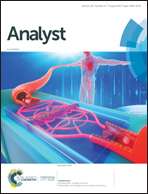Detection of Escherichia coli O157:H7 and Salmonella enterica serotype Typhimurium based on cell elongation induced by beta-lactam antibiotics
Abstract
Pathogenic bacteria such as Shiga toxigenic Escherichia coli and Salmonella can cause severe food-borne diseases. Rapid and sensitive detection of these foodborne pathogens is essential to ensure food safety. In this study, a novel method based on cell elongation induced by beta-lactam antibiotics for direct microscopic counting of Gram-negative bacteria was established. Combined with the sample preparation steps of membrane filtration and magnetic separation, the detection of E. coli O157:H7 and Salmonella enterica serotype Typhimurium was achieved by direct optical microscopic counting of the number of elongated bacteria. The limit of detection of E. coli O157:H7 and S. typhimurium could reach 20 CFU mL−1. The recovery tests for E. coli O157:H7 and S. typhimurium in water and milk samples showed acceptable recovery values between 93.6% and 106.2%. This method is sensitive, cost effective, and rapid (<2 h) and shows great potential for the detection of Gram-negative pathogens in various environmental and food samples.



 Please wait while we load your content...
Please wait while we load your content...